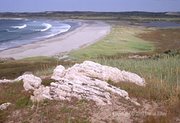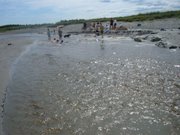 Windmill Bight Park is on Route 330 approximately two kilometres east of Lumsden, NL. Running through the park’s 39 hectares is a productive salmon river, a trout river, a freshwater pond with a sandy beach for swimmers and a large sandy beach on it’s saltwater boundary. We offer 29 private sites and a large overflow area which includes 11 RV hook-ups. Several of the sites are positioned along the two rivers and are very popular with visitors. Each site has a picnic table and fire pit with firewood available at the park office. A dumping station is located in nearby Lumsden, and a public laundry and shower facilities are just 2km away.
Windmill Bight Park is on Route 330 approximately two kilometres east of Lumsden, NL. Running through the park’s 39 hectares is a productive salmon river, a trout river, a freshwater pond with a sandy beach for swimmers and a large sandy beach on it’s saltwater boundary. We offer 29 private sites and a large overflow area which includes 11 RV hook-ups. Several of the sites are positioned along the two rivers and are very popular with visitors. Each site has a picnic table and fire pit with firewood available at the park office. A dumping station is located in nearby Lumsden, and a public laundry and shower facilities are just 2km away.
Windmill Bight Park’s day-use area has sandy, salt and freshwater beaches. Our warm, shallow freshwater pond is bordered on one side by picnic tables, private change rooms, and outhouses. Another side of the pond is bordered by a large sand dune, which has been washed up by the tides of the Atlantic Ocean.

This picturesque area has many historical attractions and traditional down-home Newfoundland & Labrador hospitality and culture. Some of our other favourite local attractions are:
-Barbour Living Heritage Village in nearby Newtown, New-Wes-Valley
-Random Passage Trail, Cape Freels
-Greenspond Courthouse (circa 1899), Greenspond
-Bonavista North Regional Museum, Wesleyville, New-Wes-Valley
-Banting Interpretation Centre, Musgrave Harbour
We’d also like to thank the Towns of Lumsden and New-Wes-Valley for their support and we encourage you to visit both on your journey through Bonavista North.












